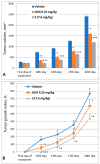Comparative Evaluation of the Antibacterial and Antitumor Activities of Marine Alkaloid 3,10-Dibromofascaplysin
- PMID: 39997192
- PMCID: PMC11857626
- DOI: 10.3390/md23020068
Comparative Evaluation of the Antibacterial and Antitumor Activities of Marine Alkaloid 3,10-Dibromofascaplysin
Abstract
Fascaplysins form a group of marine natural products with unique cationic five-ring coplanar backbone. Native fascaplysin exhibits a broad spectrum of bioactivities, among which the cytotoxic activity has been the most investigated. Several fascaplysin derivatives have more selective biological effects and are promising as lead compounds. Thus, the introduction of a substituent at C-9 of fascaplysin leads to a strong increase in its antimicrobial properties. Here, a comparative assessment of the antimicrobial activity of synthetic analogs of the marine alkaloids 3-bromofascaplysin, 10-bromofascaplysin, and 3,10-dibromofascaplysin, along with some of their isomers and analogs, was carried out against a panel of Gram-positive bacteria in vitro. For the first time, a significant increase in the antimicrobial activity of fascaplysin was observed when a substituent was introduced at C-3. The introduction of two bromine atoms at C-2 and C-9 enhances the antimicrobial properties by 4 to 16 times, depending on the tested strain. Evaluation of the antimicrobial potential in vivo showed that fascaplysin and 3,10-dibromofascaplysin had comparable efficacy in the mouse staphylococcal sepsis model. Additionally, 3,10-dibromofascaplysin demonstrated a strong and reliable antitumor effect in vivo on the Ehrlich carcinoma inoculated subcutaneously, with a value of tumor growth inhibition by 49.2% 20 days after treatment. However, further studies on alternative chemical modifications of fascaplysin are needed to improve its chemotherapeutic properties.
Keywords: 3,10-dibromofascaplysin; antibacterial activity; antitumor efficacy; fascaplysin derivatives.
Conflict of interest statement
The authors declare no conflicts of interest.
Figures







References
-
- Roll D.M., Ireland C.M., Lu H.S.M., Clardy J. Fascaplysin, an unusual antimicrobial pigment from the marine sponge Fascaplysinopsis sp. J. Org. Chem. 1988;53:3276–3278. doi: 10.1021/jo00249a025. - DOI
Publication types
MeSH terms
Substances
Grants and funding
LinkOut - more resources
Full Text Sources
Medical
Molecular Biology Databases
Research Materials
Miscellaneous

